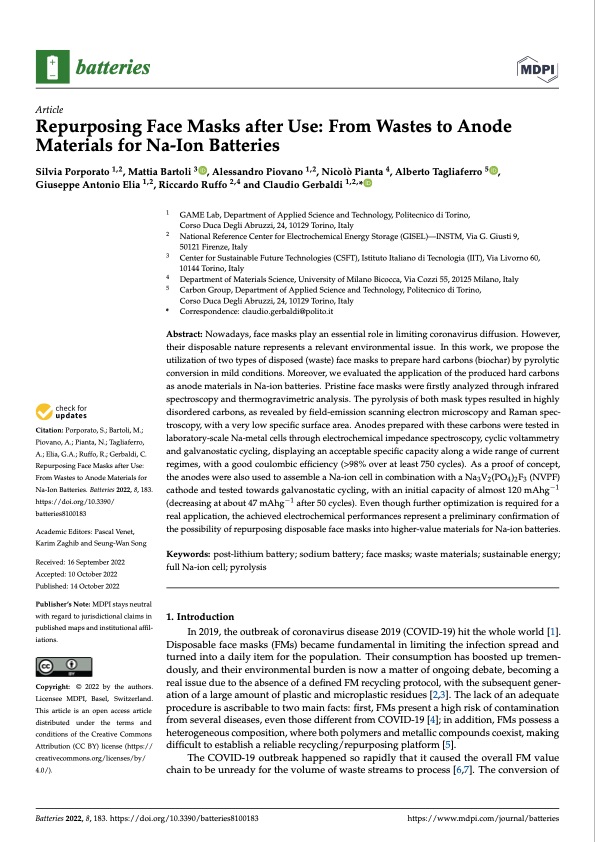
PDF Publication Title:
Text from PDF Page: 001
batteries Article Repurposing Face Masks after Use: From Wastes to Anode Materials for Na-Ion Batteries Silvia Porporato 1,2, Mattia Bartoli 3 , Alessandro Piovano 1,2, Nicolò Pianta 4, Alberto Tagliaferro 5 , Giuseppe Antonio Elia 1,2, Riccardo Ruffo 2,4 and Claudio Gerbaldi 1,2,* 1 2 3 4 5 * Correspondence: claudio.gerbaldi@polito.it Abstract: Nowadays, face masks play an essential role in limiting coronavirus diffusion. However, their disposable nature represents a relevant environmental issue. In this work, we propose the utilization of two types of disposed (waste) face masks to prepare hard carbons (biochar) by pyrolytic conversion in mild conditions. Moreover, we evaluated the application of the produced hard carbons as anode materials in Na-ion batteries. Pristine face masks were firstly analyzed through infrared spectroscopy and thermogravimetric analysis. The pyrolysis of both mask types resulted in highly disordered carbons, as revealed by field-emission scanning electron microscopy and Raman spec- troscopy, with a very low specific surface area. Anodes prepared with these carbons were tested in laboratory-scale Na-metal cells through electrochemical impedance spectroscopy, cyclic voltammetry and galvanostatic cycling, displaying an acceptable specific capacity along a wide range of current regimes, with a good coulombic efficiency (>98% over at least 750 cycles). As a proof of concept, the anodes were also used to assemble a Na-ion cell in combination with a Na3 V2 (PO4 )2 F3 (NVPF) cathode and tested towards galvanostatic cycling, with an initial capacity of almost 120 mAhg−1 (decreasing at about 47 mAhg−1 after 50 cycles). Even though further optimization is required for a real application, the achieved electrochemical performances represent a preliminary confirmation of the possibility of repurposing disposable face masks into higher-value materials for Na-ion batteries. Keywords: post-lithium battery; sodium battery; face masks; waste materials; sustainable energy; full Na-ion cell; pyrolysis 1. Introduction In 2019, the outbreak of coronavirus disease 2019 (COVID-19) hit the whole world [1]. Disposable face masks (FMs) became fundamental in limiting the infection spread and turned into a daily item for the population. Their consumption has boosted up tremen- dously, and their environmental burden is now a matter of ongoing debate, becoming a real issue due to the absence of a defined FM recycling protocol, with the subsequent gener- ation of a large amount of plastic and microplastic residues [2,3]. The lack of an adequate procedure is ascribable to two main facts: first, FMs present a high risk of contamination from several diseases, even those different from COVID-19 [4]; in addition, FMs possess a heterogeneous composition, where both polymers and metallic compounds coexist, making difficult to establish a reliable recycling/repurposing platform [5]. The COVID-19 outbreak happened so rapidly that it caused the overall FM value chain to be unready for the volume of waste streams to process [6,7]. The conversion of GAME Lab, Department of Applied Science and Technology, Politecnico di Torino, Corso Duca Degli Abruzzi, 24, 10129 Torino, Italy National Reference Center for Electrochemical Energy Storage (GISEL)—INSTM, Via G. Giusti 9, 50121 Firenze, Italy Center for Sustainable Future Technologies (CSFT), Istituto Italiano di Tecnologia (IIT), Via Livorno 60, 10144 Torino, Italy Department of Materials Science, University of Milano Bicocca, Via Cozzi 55, 20125 Milano, Italy Carbon Group, Department of Applied Science and Technology, Politecnico di Torino, Corso Duca Degli Abruzzi, 24, 10129 Torino, Italy Citation: Porporato, S.; Bartoli, M.; Piovano, A.; Pianta, N.; Tagliaferro, A.; Elia, G.A.; Ruffo, R.; Gerbaldi, C. Repurposing Face Masks after Use: From Wastes to Anode Materials for Na-Ion Batteries. Batteries 2022, 8, 183. https://doi.org/10.3390/ batteries8100183 Academic Editors: Pascal Venet, Karim Zaghib and Seung-Wan Song Received: 16 September 2022 Accepted: 10 October 2022 Published: 14 October 2022 Publisher’s Note: MDPI stays neutral with regard to jurisdictional claims in published maps and institutional affil- iations. Copyright: © 2022 by the authors. Licensee MDPI, Basel, Switzerland. This article is an open access article distributed under the terms and conditions of the Creative Commons Attribution (CC BY) license (https:// creativecommons.org/licenses/by/ 4.0/). Batteries 2022, 8, 183. https://doi.org/10.3390/batteries8100183 https://www.mdpi.com/journal/batteriesPDF Image | From Wastes to Anode Materials for Na-Ion Batteries

PDF Search Title:
From Wastes to Anode Materials for Na-Ion BatteriesOriginal File Name Searched:
batteries-08-00183.pdfDIY PDF Search: Google It | Yahoo | Bing
Salgenx Redox Flow Battery Technology: Salt water flow battery technology with low cost and great energy density that can be used for power storage and thermal storage. Let us de-risk your production using our license. Our aqueous flow battery is less cost than Tesla Megapack and available faster. Redox flow battery. No membrane needed like with Vanadium, or Bromine. Salgenx flow battery
| CONTACT TEL: 608-238-6001 Email: greg@salgenx.com | RSS | AMP |